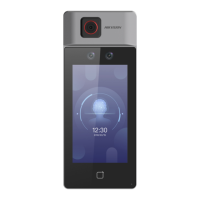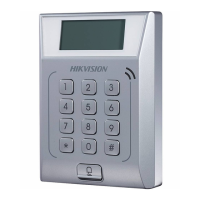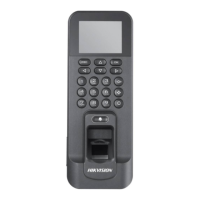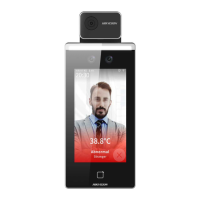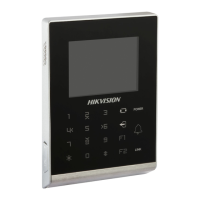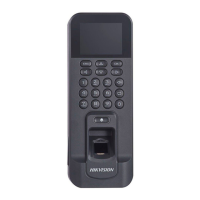
Do you have a question about the HIKVISION DS-K1T6QT-F43 Series and is the answer not in the manual?
| Model | DS-K1T6QT-F43 Series |
|---|---|
| Category | IP Access Controllers |
| Display | 4.3-inch touch screen |
| Operating System | Embedded Linux |
| Face Recognition Distance | 0.3 m to 1.5 m |
| Face Capacity | 10, 000 |
| Event Capacity | 100, 000 |
| Working Humidity | 10% to 90% (non-condensing) |
| Camera | 2 MP |
| Communication | TCP/IP |
| Access Control | Face, Card, Fingerprint |
| Face Recognition Duration | < 0.2 s |
| Supported Card Types | Mifare, EM |
| Input Interface | 1 x Wiegand input |
| Output Interface | 1 x alarm output |
| Power Supply | 12 VDC/1 A |
Provides instructions for using and managing the product, with charts and images for explanation.
Lists trademarks and logos of Hikvision and other companies as properties of their respective owners.
Outlines the terms of use, liability limitations, and security risks associated with the product and internet usage.
Details FCC compliance, limits for Class B devices, and measures to correct interference.
Confirms product compliance with harmonized European standards like EMC, RE, and RoHS directives.
Describes the face recognition terminal as an access control device for various applications.
Lists the key features of the device, including its display, camera, capacity, and connectivity options.
Specifies optimal conditions for device installation, avoiding backlight and reflective objects for better performance.
Provides steps for installing the device using a gang box, including securing the mounting plate.
Explains the process of base mounting the device, including routing cables and fastening the bracket.
Describes the function, color, name, and description of each terminal on the device.
Explains how to connect the terminal with normal peripherals for standard operation.
Provides instructions on wiring the device with a secure door control unit for enhanced security.
Details wiring diagrams for fire linkage scenarios, ensuring door operation during power outages.
Explains how to activate the device directly through its interface by setting a password.
Describes the process of activating the device using a web browser by accessing its IP address.
Details activating the device and modifying its IP address using the SADP tool over the LAN.
Explains how to activate the device using the iVMS-4200 client software before adding it to the system.
Guides on selecting the system language for the device interface after activation.
Allows users to set a method (email or security questions) for password recovery if the device password is forgotten.
Instructs on selecting an application mode (Indoor or Others) for optimal device performance.
Details how to configure wired or Wi-Fi network parameters for device connectivity.
Explains how to enable and configure access to platforms like Hik-Connect for remote management.
Covers setting privacy parameters for picture uploading, storage, and data handling.
Guides on adding an administrator to manage device parameters and permissions.
Explains different methods to log into the device, either by administrator or activation password.
Details configuration of network, Wi-Fi, RS-485, Wiegand, ISUP, and platform access.
Covers adding, editing, deleting, and searching users, including their credentials and roles.
Provides procedures for deleting, importing, and exporting device data, including user information and pictures.
Explains how users can authenticate using single or multiple credentials like face, fingerprint, or card.
Covers configuration of shortcut keys, theme, voice, time, language, and other basic device settings.
Allows customization of face recognition parameters to improve performance and security.
Details setting access control permissions, including authentication modes, card reader settings, and door contact options.
Covers setting attendance modes (manual, auto, disable) and schedules for tracking user presence.
Explains system information viewing, factory reset, default settings restoration, and device reboot procedures.
Guides on logging into the device via a mobile browser to access its configuration settings.
Explains how to search for events using various criteria like employee ID, name, and time.
Covers adding, editing, deleting, and searching users through the mobile web interface.
Details various configuration options accessible via the mobile browser, such as device information and time settings.
Explains how to log in to the device via a web browser or remote client software.
Provides steps to reset the forgotten password using email verification or security questions.
Guides on viewing the live video feed of the device and performing operations like capture and recording.
Covers adding and managing person information, including basic details, cards, and face pictures.
Explains how to search for events using criteria such as employee ID, name, and time.
Details various device configuration settings, including local parameters, network, system, and image settings.
Presents a flowchart illustrating the steps for configuring the client software.
Covers adding, managing, and resetting devices within the client software.
Explains how to organize devices and resources into groups for efficient management.
Details managing person information, including adding organizations, importing/exporting data, and issuing cards.
Guides on setting up holiday and week schedules for access authorization templates.
Explains creating access groups and assigning permissions to persons for specific doors.
Covers configuring advanced access control functions like device parameters and alarm outputs.
Details real-time monitoring and control of doors, including their status and access records.

